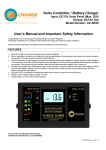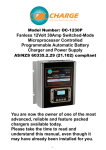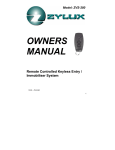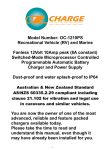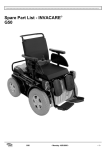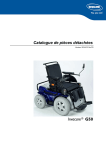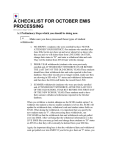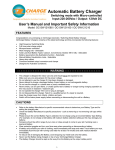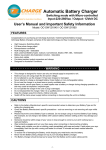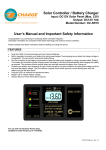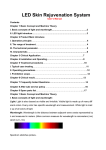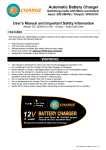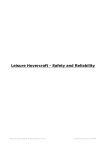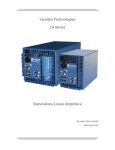Download DOWNLOAD User Manual here
Transcript
Model Number: OC-1230P Fanless 12Volt 30Amp Switched-Mode Microprocessor Controlled Programmable Automatic Battery Charger and Power Supply You are now the owner of one of the most advanced, reliable and feature packed chargers available today. Please take the time to read and understand this manual, even though it may have already been installed for you. -1- Installation and User’s Manual. FEATURES Congratulations on purchasing an OzCharge fully automatic switched-mode battery charger. OzCharge battery chargers comprise of the latest technology and incorporate the following features: High frequency Switching Mode with pulse charge output Microprocessor controlled No fan! No noise to keep you awake and no moving parts to wear out Built in surge protection AC and DC quick connect plugs Automatic Power-Supply mode Re-locatable Liquid Crystal Display (LCD) remote Multi charging rate (user selectable) Suits all Lead Acid battery types: Calcium, Conventional, Absorbed Glass Mat (AGM), Gel (DIP switch selectable – AGM default) Battery rejuvenation (De-Sulphation) function (user selectable) Heavy-duty cables Designed for Australian & New Zealand conditions and applications - - - - - - - - - - - - - - - - - - - WARNING - - - - - - - - - - - - - - - - - - - - Before removing the LCD remote, programming, connecting or disconnecting the unit to a battery always switch off and unplug the AC mains supply and battery DC connection. This charger is designed for indoor use only and should never be exposed to water, rain, etc. Make sure you are using proper AC line power voltage. Do not attempt to use the charger if it has been dropped or damaged. Never attempt to charge a damaged battery, frozen battery or non-rechargeable battery. Do not use the charger in a closed area or poorly-ventilated area. Never smoke, use an open flame, or create sparks near a battery or charger during charging operation as this may cause an explosion / explosive gas. Do not operate the charger if any of the cables or plugs are damaged. Do not disassemble the charger. Take it to a qualified and authorised person if any repair is required. Keep the charger away from infants, children and pets. CAUTIONS Ensure the correct Battery Type is selected with the DIP switch before the first use or battery replacement. Do not charge using an incorrect Battery Type setting. (For example, do not charge a Gel battery with Calcium battery selection setting or vice-versa as this may damage your battery) Refer to the Battery Manufacture‟s specific recommended charging voltages to determine your Battery Type and for setting the charging rate. Incorrect Battery Type Selection may result in you Battery being under charged or over charged. Check the Battery Manufacture‟s specific precautions. eg: Such as removing or not removing cell caps whilst charging. As a precaution, someone should be within range of your voice or close enough to come to your aid if working near a lead-acid battery. Wear protective goggles and turn your face away when connecting or disconnecting a battery. If battery acid contacts your skin or clothing, wash immediately with soap and water. If acid enters your eye, immediately flush the eye with running cold water for at least 10 minutes and seek medical attention. To reduce risk of damaging the battery, avoid dropping any metal tools onto the battery. Wrap spanners with electrical insulation tape to minimise the risk of a short circuit. Never rest the Battery being charged on top of your OzCharge Battery Charger. The Battery Charger should be kept as far away from the Battery as the output cables permit. -2- CONTROL AND INDICATORS 1. LCD. Shows software version when first connected. Constantly shows the battery voltage or charging amps current depending on the Amp/Volt button (see point 7 below) when AC mains is applied. Display and backlight automatically extinguishes when there is no AC mains present after one minute. Press any button to view the battery voltage when the display is blank. Note the battery must be over 10.0V for the LCD to work. 2. Battery type. This shows what the DIP switch has been programmed to. Refer to page 5 before first use! 3. State Of Charge (SOC) meter. Basic battery health indicator. 4. On/Off button. Manual over-ride. Hold down for three seconds to activate. 5. Rejuvenation button. For restoring over-discharged batteries. Refer to page 7 before use! 6. Charging Amps button. For manually changing the output current limit. May require adjustment for some batteries or for use with small AC mains supplies (ie: a very small generator). Refer to page 6 before use! 7. Amp/Volt button. Press to alternately see the battery voltage or output current. 8. Power LED (green). Shows when AC mains is present. 9. Bulk LED (yellow). Shows when the charger is in the first stage. Blinking indicates a soft start due to a deeply discharged battery. 10. Absorption LED (blue). Shows when the charger is in the second stage. Blinking indicates automatic Equalisation (Calcium battery only) or manual Rejuvenation mode. 11. Float LED (green). Shows when the charger is in the final trickle charge stage. Blinking indicates first hour of Float mode as “Analysis” mode. 12. Fault LED (red). Shows when there is a fault or error detected. Refer to Trouble Shooting page for more information. -3- INSTALLATION This product is designed to be installed in a hardwired situation only. Because this charger has no fan it is important to mount it in an upright position only. Nothing should located be within 100mm (4 inches) of the main charger unit to ensure natural convection cooling takes place. Choose a suitable location that meets these requirements. In caravans especially make sure the location is not used for storage of things that may limit the airflow like tents/swags/canvas awnings that may wrap around the unit during travel and not be unfolded or used at the next destination. NOTE this condition is not a danger as the unit will automatically “foldback” and reduce the output the current in the event of overheating and continue to work at a lower power level, and the battery recharge time will be longer. Only in extreme ambient heat environments the unit may shutdown. 1. Mounting location. Screw only to a solid, stable surface in the upright position only. 2. Re-locatable LCD. WARNING! Turn off and remove the AC and DC plugs before attempting to unscrew the LCD. IMPORTANT! Install the blanking plate provided immediately. 3. AC mains input plug. For use with 230-240Vac only. 4. Surge protection fuses. These are commonly blown by poor mains supplies like unregulated generators. Replace only with the same type and rating. Always turn off and remove AC mains power plug before checking or replacement. Note there are two fuses to check (one is on the mains Active and the other is on the mains Neutral of the AC supply). 5. Remote LCD socket. Use when the LCD has been re-located. Cable is a standard telephone extension. 10m maximum. 6. Programming DIP switch. Located under the cover. Setup the correct battery charge voltage/type. IMPORTANT! This must be done prior to the first use, or after a battery replacement. Default setting is for Absorbed Glass Mat (AGM) battery type. 7. DC output plug. Connect directly to the battery with as little cable as possible. Shorten the cable that comes with the unit if necessary. We do not recommend using or making a longer cable than the one provided. -4- DIP SWITCH PROGRAMMING The default out-of the-box factory setting will probably suit most new installations which are; Absorbed Glass Mat (AGM) battery type Charge Voltage: 14.5V Float Voltage: 13.7V DIP switch: 1 = Off, 2 = Off, 3 = On, 4 = Off, 5 = On, 6 = Off, 7 = On, 8 = On. If your battery type is different, or you have replaced the battery these are the available adjustments; AUTOMATIC POWER-SUPPLY MODE This charger will automatically become a power supply in the event there is no battery connected or there has been a total battery failure. If there has never been a battery installed in your caravan/RV/boat you must have this unit plugged into AC mains to be able to operate the lights, TV, etc. If you decide to install a battery at a later stage, you do not need to purchase another charger. Simply have a suitable battery installed by a professional automotive-electrician and check the DIP switch is correctly set for that battery type. If you have a battery installed and suspect there has been a battery failure of any kind, this feature will allow you to still be able to operate your DC loads such as lights and TV because the charger will still turn on when the battery has been disconnected and/or removed. If this happens, disconnect the AC mains and have an automotive-electrician to disconnect the battery Negative terminal and then secure and insulate the cable so it cannot short-circuit or make contact with anything. When AC mains is reapplied with no battery connected, the charger will automatically restart as a Power Supply. When the problem is fixed or faulty battery is replaced, it will automatically restart as a Battery Charger. USE WITH OTHER CHARGING SOURCES It is quite common in installations where this charger will be used to have other methods of charging the batteries also connected (and possibly in use) at the same time. Because this charger is has been designed as a voltage regulated product, there is little chance of this being a problem. Most alternators, solar controllers, DC-DC chargers, etc will not cause any ill-effect if used at the same time. However, we recommend that you check with the other equipment suppliers if you are not sure. STORAGE This charger requires a small constant amount of “backfeed” power to run the microprocessor and the LCD when there is no AC mains present. This is not a problem if you are travelling and using the charger on a regular basis. It is also not a problem is you have uncovered solar panels always keeping the battery “topped up” too. Where this can be a problem is if the vehicle is in storage for a few months or more at a time, and the battery can be deeply discharged and damaged. To avoid this there are two options; Leave the AC mains permanently connected (recommended), or Charge the battery fully for 24 hours, then unplug the main DC connector or disconnect the battery Negative terminal. Keep in mind that all batteries have a certain rate of “self discharge” and will eventually go flat by themselves, so we recommend the charger be left connected to AC mains when not in use. -5- RECOMMENDED BATTERY CAPACITY & CHARGE CURRENT This product is designed to be installed in a hardwired situation therefore the battery capacity will normally be a fixed size and determined by the vehicle manufacturer. If the battery was supplied and installed in a caravan or RV, ask the manufacturer what make and model they have supplied as the battery is often out of sight and/or in a protective box. For all other installations such as marine and offgrid solar installation refer to the battery label or system owner‟s manual. Always refer to the battery manufacturer for the maximum allowable charge current. Most batteries normally specify and can tolerate between 10% to 30% of their nominal Ampere-Hour (Ah) size as charge current. eg: a 97Ah battery should be recharged between 9.7Amps and 29.1Amps) NOTE: Never charge a battery below 5% of its nominal Ampere-Hour (Ah) size or the charge time will be too long and risk sulphation. eg: a 105Ah battery should always be charged with more than 5.25Amps. As a general rule always leave the charger set on its highest output because it will be normally supplying standing DC loads such as lights, TV, fridge, etc at the same time it is trying to charge the battery. All of these loads “steal” power away from the battery leaving only the difference available. eg: if the charger working at its full 30Amp output and running 12Amps of other loads simultaneously, there is only have 18Amps left available to charge the battery. Using the highest charge rate will dramatically reduce the recharge time too, which is especially important when using a generator as it will save a significant amount of fuel, money, and time. USE WITH GENERATORS This product is designed for safe use with generators. It includes inbuilt surge protection and two AC protection fuses on the incoming mains AC lines, but this does not cure a bad generator. We recommend only using “inverter” type generators (ie: Honda EU or Yamaha EF-iS) or generators with an Automatic Voltage Regulator (AVR) on the alternator. If you are using a 2-stroke or open frame “tradesman” type generator without an AVR, we highly recommend using an additional surge protector at the generator outlet (ie: Dick Smith part # M7404). The charger requires approx 500Watts to run at its full output. Therefore we recommend the smallest generator used to run this charger is 1kVA (1000VA). IMPORTANT: Test your generator with the charger before you leave home! When running your generator for the first time with the charger, check the maximum Amps that can be supplied by the charger. To do this, first make sure there is no incoming AC mains supply to the charger by checking the Power LED is off. Turn on all of the DC loads possible (all lights, TV, etc) for a few minutes and make sure the battery is not fully charged. Connect and start the generator and by pressing the Amps/Volts button, check the charger output Amps. It should show the charger working at (or very close to) its full 30A rated output. If it is not showing the full 30A rated output, decrease the charger output by pressing the Charging Amps button so that it is slightly lower, to prevent the generator from being overloaded. eg: If when running the generator, the charger can only supply 17Amps maximum, set the charger output to 15Amps. NOTE if you need to set the charger to a lower Charging Amps output value to run on your generator, don‟t forget to increase it again when you are connected back to a powered site or at your home or your batteries will take much longer to recharge. -6- OPERATING INSTRUCTIONS This OzCharge battery charger has been designed to be easy to operate and very simple to use. Please refer to the operating instructions below. 1. Pre-Charge Check (a) Check the Battery Electrolyte level (Non-sealed Batteries). If necessary, remove the vent caps and add distilled water so the levels are halfway between the upper and lower fill lines. (b) Location – Ensure the Battery is in a well ventilated area. Never charge a conventional wet cell battery inside a caravan! This includes “Calcium” maintenance-free types. Refer to Australian / New Zealand Standards 2676 and 3011 for legal indoor battery installations. (c) If your charger came as Original Equipment (OE) with your caravan, ignore this step. Keep the Charger as far away from Battery as the cables permit. Never place the charger directly above the battery being charged as gasses from the Battery will corrode and damage the charger. Always keep the charger away from high corrosion / wet and moist areas. 2. Connecting the charger to your battery (a) (b) (c) (d) Because this product is designed to be hardwired, this step will normally be done as part of the original installation. Connect the Red lead from the charger directly to the positive (+) battery terminal. Connect the Black lead from the charger directly to the negative (-) battery terminal. Do not connect to the chassis, fuel rails, brake lines, etc. When multiple batteries are installed in parallel, always use a fuse or DC circuit breaker as close to each battery as possible. If connecting the charger to batteries in parallel, connect the charger output lead to each of the opposite ends of the battery bank to minimise any voltage drop in each battery interconnect. 3. Connect the battery charger to the mains power (230-240Vac) (a) Note this could be from a generator, powered site, marina, or your home. (b) The Charger will automatically start when AC power is connected. (Note: If the Fault Indicator LED illuminates Red, please check your connections as the most common problem is that the Positive and Negative Leads are reversed. Refer to Trouble Shooting Page for further information) (c) Select the desired charge rate: Leave this on the highest (30A) setting normally unless being used with a very small generator, or on advice from the battery supplier. (d) Ensure the Battery Type on the LCD matches your battery installed! Note: The charger will automatically memorise your charging rate setting and battery type setting. The next time you use the charger it will default to the last setting. -7- The Charging process The charging LED‟s indicate all of the Charging Stages. The charging stages are in this order as follows: ●Soft start: A Soft Start will only occur if the initial battery voltage is between 3V and 11V due to a deep discharge. During a Soft Start the unit will charge the battery using half the maximum current (as set by the Charging Amps button) until the battery voltage is over 11V. (Indicated by the yellow Bulk LED flashing). If the yellow Bulk LED is blinking, turn off all the loads possible (lights, TV, etc) until the Bulk LED turns solid and stops blinking. ●Bulk Charge: Charges the battery using a constant maximum current (as set by the Charging Amps button) until the battery rises to the absorption level. (Indicated by the yellow Bulk LED on solid) ●Absorption: This stage charges the battery using a constant voltage to get the battery state of charge over 85%. The charging voltage for this stage is determined by the Battery Type selection DIP switch (located on the bottom of the charger) (Indicated by the blue Absorption LED on solid) ●Equalising: This is an automatic stage when the battery type is programmed for Calcium only. (Indicated by the blue Absorption LED flashing) ●Analysis: ●Float: Diagnoses the battery condition. (Indicated by the green Float LED flashing) Battery is fully charged. It will be trickle charged and maintained at a safe constant voltage determined by the Battery Type selection DIP switch (located on the bottom of the charger). (Indicated by the green Float LED on solid) Rejuvenation mode (EXTEND YOUR BATTERY LIFE) Your OzCharge battery charger provides a unique battery “Rejuvenation” function. What does this feature do? The Rejuvenation mode has been proven to break down the crystalline form of lead sulphate (commonly called “Sulphation” pronounced Sul-Fay-Shon) within the battery cells which helps extend your battery life. Sulphation can occur when batteries are regularly discharged, have insufficient recharge time and/or they are left in a discharged state. We recommend that you periodically use this rejuvenation (De-Sulphate) feature to ensure you get the maximum life out of your battery, only when connected to mains power (not on a generator due to the time and fuel that would be required). While there are no and fast hard rules to follow, we suggest that if you use the battery on a daily basis, Rejuvenation once a month is adequate. If you use the battery a few times a year, every six months or so is enough. To activate the Rejuvenation feature, simply press and hold the „Rejuve-nation‟ button for 3 Seconds until the blue Absorption LED begins flashing. Once the charger has entered the rejuvenation (de-sulphate) charging stage, the process will automatically time-out after 24 hours, or you can manually stop this process at any time by pressing and holding down the „Rejuve-nation‟ button for 3 seconds again. -8- CHARGING STAGES Note: The Charger automatically switches off after 24 hours if the Bulk charge cycle is not completed. CHARGER SPECIFICATIONS 1. 2. 3. Input: Charging starting conditions: Rated output: Type of battery: 4. 5. Charging output voltage: 6. Float output voltage: 7. Equalise voltage: 8. Operating Environmental: 9. Net Weight (kg): 10. Dimensions (mm): 220~260Vac; 50Hz; Battery is not less than 3.0V 13.8Volts at 30Amps DC Lead-acid only (not Nickel-Cadmium, Lithium, etc). Conventional/Calcium/AGM (default)/Gel 14.0/14.1/14.2/14.3/14.4/14.5/14.6/14.7V programmable for the “Absorption” stage 13.5/13.6/13.7/13.8V programmable for the finish trickle charge stage 15.5V current limited. Automatic for Calcium battery types only 0~40 degC, 90% RH maximum; non-Condensing 3.7 (approx.) 250L x 252W x 97W TROUBLE SHOOTING Problems Charger does not work Indication Indicator lights are not on Possible causes No AC power Fuse/s are blown due to poor AC mains. Charger has no DC output Green Power LED is on. No Charging Current Fault LED is ON. Suggest solution Check the AC plug connection at the base of the main unit. Unplug the AC mains and check both fuses (there are two) on the base of the main unit. Have the generator checked. Unit is OFF. No battery connection. Press the ON-OFF button for 3 seconds. Check the battery connection is secure. Check the DC plug is fully connected in the base of the main unit (it is very hard to plug/unplug to prevent vibration from accidental disconnection) Check the battery voltage is over 3V. Code E01 on the LCD Output is shorted or Battery is connected in reverse. Code E02 on the LCD Soft Start mode has timed out Code E03 on the LCD Bulk charge mode has timed out Code E04 on the LCD Analysis mode detected a bad cell. Code E05 on the LCD Over temperature shutdown Check the DC cabling. Check the polarity of the battery connection. Battery is in extremely poor condition. Turn off all loads. Restart the charger. Run the Rejuvenate mode. Replace battery if necessary. Battery is in extremely poor condition. Check Charge Amps is set on maximum. Turn off all loads. Restart the charger. Run the Rejuvenate mode. Replace battery if necessary. Battery is in poor condition probably due to age. Run the Rejuvenate mode. Replace battery if necessary. Check the main unit is not covered and the vents are not blocked. Allow to cool. Restart the charger. -9- 2 YEAR MANUFACTURER WARRANTY Zylux Distribution Pty. Ltd. (OzCharge) warrants to the Customer that this product is substantially free from defects in materials and workmanship under normal use for a period of Two Years from the Date of Purchase. Please ensure you keep a copy of your purchase on file as this will be required to validate your warranty. Obtaining Warranty Service Within the warranty period, the Customer must contact the authorised supplier / installer / retailer where the product was purchased or alternatively you can contact the OzCharge service centre through one of the following methods: Identify the serial number and software version first! The serial number is on the front of the main unit and the software version is displayed on the LCD when first connected. Hotline: Website: Australia (03) 9482 2203 www.ozcharge.com.au New Zealand (09) 527 7260 www.ozcharge.co.nz If the Authorised Supplier and / or OzCharge service centre concludes that while under normal use, a product failure or malfunction occurred during the warranty period and was caused by a defect in material or workmanship (see Exclusions), the Customer will be asked to ship to the nearest service point for repair or replacement, at our discretion. The product must be packaged appropriately for safe shipment. To prove that the product is under warranty, the customer should enclose a copy of their receipt for proof of purchase. It is recommended that returned products be sent by registered mail as Zylux Distribution Pty Ltd. (OzCharge) accepts no responsibility / liability for goods lost or damaged in transit. Return Shipping costs to be incurred by the Customer. Exclusions If upon receiving a product for repair and if testing and examining the product has disclosed that the alleged defect or malfunction in the product does not exist or was caused by the Customer or any third persons misuse, physical abuse, water or lightning damage, unauthorised attempts to open, repair or modify the product or improper installation, this will not be covered under this warranty. This Warranty is void if: 1. The product has been tampered with or repaired by an unauthorised person. 2. The warranty seal is broken or altered. 3. The warranty period has expired. Specifications subject to change without notice. Distributed by Zylux Distribution Pty. Ltd. ABN: 66 101 378 009 © 2011 Rev_1.7 -10-










